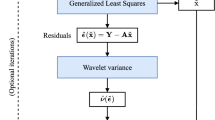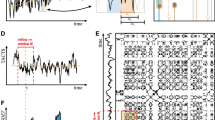Abstract
Environmental information of the past can be obtained by processing and analyzing proxies recorded by environmental archives. Natural archives are sampled at a distance grid along their accretion axis. Starting from these distance series, a time series needs to be constructed, because comparison of different data records is only meaningful on a time grid. However, distance–time relationships are nonlinear as the accretion rate of natural archives is dependent on environmental and physiological factors. Furthermore, in environmental archives, samples are taken over a volume in distance, rather than over a point in distance. This implies that the sample-values will be averaged over the volume of the sample. In this paper a method is proposed, which establishes the nonlinear distance–time relationship and corrects for the averaging effects. The method is built upon the assumption that the proxy record on a time axis is harmonic. If this is not the case, then a harmonic approximation is made. As a consequence of the nonlinear distance–time relationship, this harmonic proxy signal is nonlinearly distorted on a distance axis. As such, a harmonic signal model with a nonlinear phase distortion and an averaging effect is fitted on the data. Since environmental records are short data records, the statistical performance of the estimator on noisy data is verified by means of Monte Carlo simulations. The applicability of the method is demonstrated on the measurement of the vessel density, in a mangrove tree, Rhizophora mucronata, which is an indicator of the rainfall in tropical coastal ecosystems.
Similar content being viewed by others
References
Arruda JRF (1992) Analysis of non-equally spaced data using a regressive discrete Fourier series. J Sound Vib 156(3):571–574
Beelaerts V, De Ridder F, Schmitz N, Bauwens M, Dehairs F, Schoukens J, Pintelon R (2008) On the elimination of bias averaging-errors in proxy records. Math Geosci 41(2):129–144
Briham EO (1998) The fast Fourier transform. Prentice Hall, Englewood Cliffs
De Ridder F, Pintelon R, Schoukens J (2004) Decoding nonlinear growth rates in biogenic environmental archives. Geochem Geophys Geosyst 5:(12). doi:10.1029/2004GC000771
De Ridder F, Pintelon R, Schoukens J, Verheyden A (2005a) Reduction of the Gibbs phenomenon applied on non-harmonic time base distortions. IEEE Trans Instrum Meas 54(3):1118–1125
De Ridder F, Pintelon R, Schoukens J, Gillikin DP (2005b) Modified AIC and MDL model selection criteria for short data records. IEEE Trans Instrum Meas 54(1):144–150
Dierckx P (1993) Curve and surface fitting with splines. Oxford University Press, Oxford
EPICA (2004) Eight glacial cycles from an Antarctic ice core. Nature 429:623–628
Fishman GS (1995) Monte Carlos: concepts, algorithms, and applications. Springer, New York
Fletcher R (1991) Practical methods of optimization, 2nd edn. Wiley, New York
Gillikin DP, De Ridder F, Ulens H, Elskens M, Keppens E, Baeyens W, Dehairs F (2005) Assessing the reproducibility and reliability of estuarine bivalve shells (Saxidomus giganteus) for sea surface temperature reconstruction: implications for paleoclimate studies. Palaeogeogr Palaeoclimatol Palaeoecol 228(1):70–85
Golub GH, Van Loan CF (1996) Matrix computations, 3rd edn. John Hopkins University Press, Baltimore
Goodwin DH, Prajbasaj P (2009) MoGroFunGen: a numerical model for reconstructing intra-annual growth rates of bivalve mollusks. Palaeogeogr Palaeoclimatol Palaeoecol 276:47–55
Goodwin DH, Schöne BR, Detteman DL (2003) Resolution and fidelity of oxygen isotopes as paleotemperature proxies in bivalve mollusk shells: models and observations. Palaios 18:110–125
Huang S, Pollack NH, Shen P (2000) Temperature trends over the past five centuries from reconstructed borehole temperatures. Nature 403:756–758
Kaplan W (1993) Advanced calculus. Addison-Wesley, Reading
Lisiecki LE, Lisiecki P (2002) Application of dynamical programming to correlation of paleoclimate records. Paleoceanography 17:(D4). doi:10.1029/2001PA000733
Martinson DG, Menke W, Stoffa P (1982) An inverse approach to signal correlation. J Geophys Res 87(B6):4807–4818
Paillard D, Labreyrie L, Yiou P (1996) Macintosh program performs time-series analysis. Eos Trans AGU 77(39):379
Pintelon R, Schoukens J (1996) An improved sine-wave fitting procedure for characterizing data acquisition channels. IEEE Trans Instrum Meas 45(2):588–593
Pintelon R, Schoukens J (2001) System identification: a frequency domain approach. IEEE Press, Piscataway
Pintelon R, Schoukens J, Guillaume P (2007) Box–Jenkins identification revised—Part III: multivariable systems. Automatica 43(5):868–875
Ralston A, Rabinowitz P (1984) A first course in numerical analysis. McGraw-Hill, New York
Schoukens J, Pintelon R, Vandersteen G (1997) A sine-wave fitting procedure for characterizing data acquisition channels in the presence of time base distortion and time jitter. IEEE Trans Instrum Meas 46(4):1005–1010
Stenbakken GN, Deyst JP (1998) Time-base nonlinearity determination using iterated sine-fit analysis. In: Proc IEEE IMTC, St Paul, MN, May 18–21, pp 1335–1340
Vandersteen G, Rolain Y, Schoukens J (2001) An identification technique for data acquisition characterization in the presence of nonlinear distortions and time base distortions. IEEE Trans Instrum Meas 50(5):1355–1363
Vanherzeele P, Guillaume P, Vanlanduit S, Verboven P (2006) Data reduction using a generalized regressive discrete Fourier series. J Sound Vib 298:111
Verheyden A, De Ridder F, Schmitz N, Beeckman H, Koedam N (2005) High-resolution time series of vessel density in Kenian mangrove trees reveal a link with climate. New Phytol 167(2):425–435
Verspecht J (1994) Accurate spectral estimation based on measurements with a distorted-time base digitizer. IEEE Trans Instrum Meas 43(2):210–215
Yu Z, Ding ZI (1998) An automatic orbital tuning method for paleoclimate records. Geophys Res Lett 25:4525–4528
Author information
Authors and Affiliations
Corresponding author
Rights and permissions
About this article
Cite this article
Beelaerts, V., De Ridder, F., Schmitz, N. et al. Time-Series Reconstruction from Natural Archive Data with the Averaging Effect Taken into Account. Math Geosci 42, 705–722 (2010). https://doi.org/10.1007/s11004-010-9292-7
Received:
Accepted:
Published:
Issue Date:
DOI: https://doi.org/10.1007/s11004-010-9292-7




